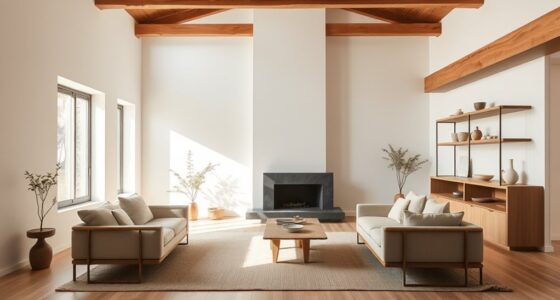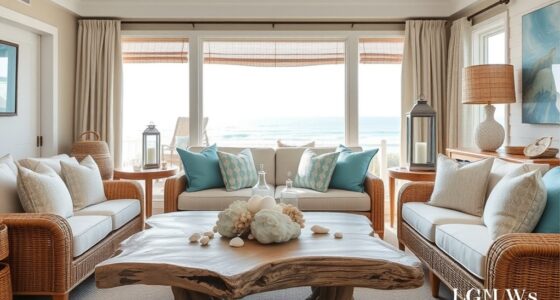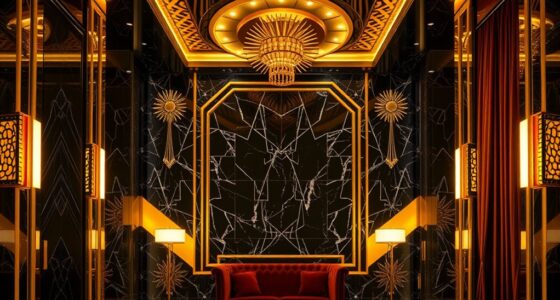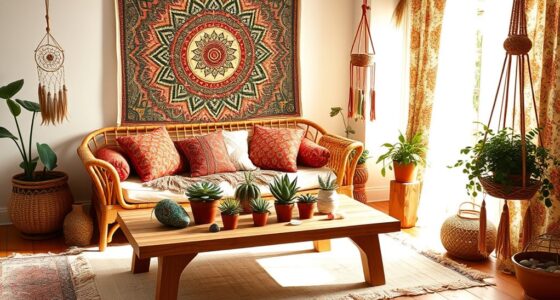Industrial style is irresistible because it combines raw, weathered surfaces with vintage charm and sleek modern touches. You’re drawn to its authenticity, where imperfect textures like rusted metal, distressed wood, and exposed brick tell a unique story. Its balance of ruggedness and sophistication creates spaces that feel genuine, durable, and timeless. Rich with character and versatility, industrial design offers a bold aesthetic that captures resilience and history—exploring this further reveals why it continues to captivate so many.
Key Takeaways
- The raw, weathered surfaces highlight material honesty and unique character, adding authenticity and a sense of history.
- The blend of vintage textures with modern design creates a timeless, balanced aesthetic.
- Durable, reclaimed materials promote sustainability and reinforce the rugged, resilient vibe.
- Open layouts and large windows maximize natural light, enhancing spaciousness and raw beauty.
- The emphasis on imperfections, distressed finishes, and aged elements gives spaces a genuine, lived-in charm.
The Raw and Authentic Aesthetic
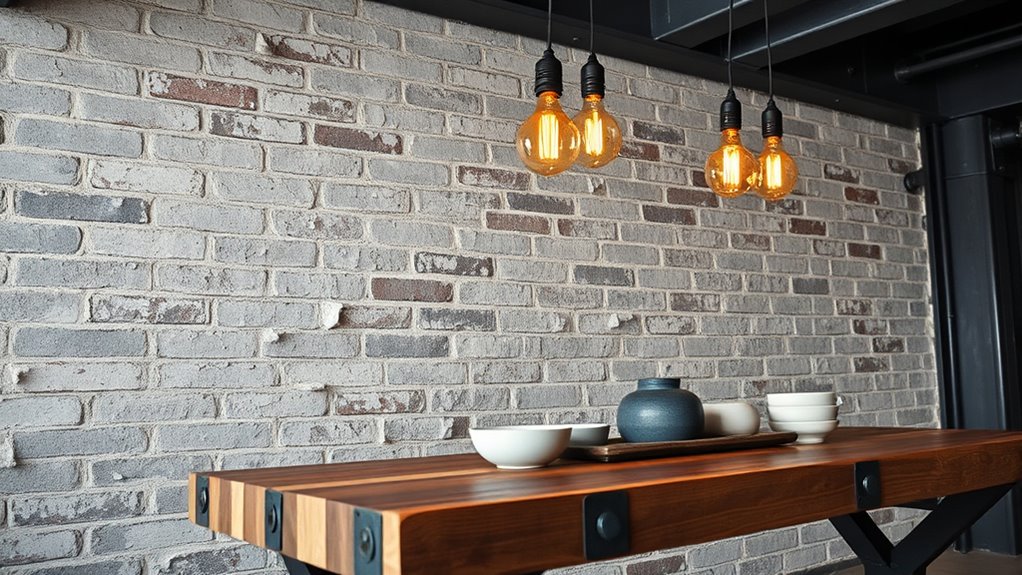
The raw and authentic aesthetic of industrial style captures the essence of its original structures through exposed brick, concrete, and weathered finishes. You’ll notice how raw textures highlight the honesty of materials and construction, creating an authentic aesthetic that feels genuine and unrefined. Exposed materials like metal beams and distressed surfaces showcase imperfections—rust, nicks, and scratches—that add character and tell a story. This style embraces an unfinished look, avoiding overly polished or decorative finishes, favoring instead a rugged, utilitarian vibe. The beauty lies in its simplicity and honesty, where each surface reveals its history. By celebrating these raw textures, industrial interiors evoke a sense of resilience, craftsmanship, and history that truly connects you to the space’s industrial past. Additionally, incorporating AI in Business technologies can optimize the design process by analyzing material choices and predicting how finishes will age over time. Embracing raw textures allows designers to craft spaces that are both functional and aesthetically compelling, emphasizing authenticity over superficial perfection. The use of contrast in textures further enhances the visual interest, highlighting the interplay between different raw surfaces. Incorporating beekeeping materials such as reclaimed wood or recycled metals can also complement this aesthetic by adding sustainable and textured elements. Moreover, understanding the importance of material authenticity helps maintain the integrity of the industrial style, ensuring each piece contributes to the overall narrative of rugged craftsmanship.
The Perfect Balance of Vintage and Modern Elements
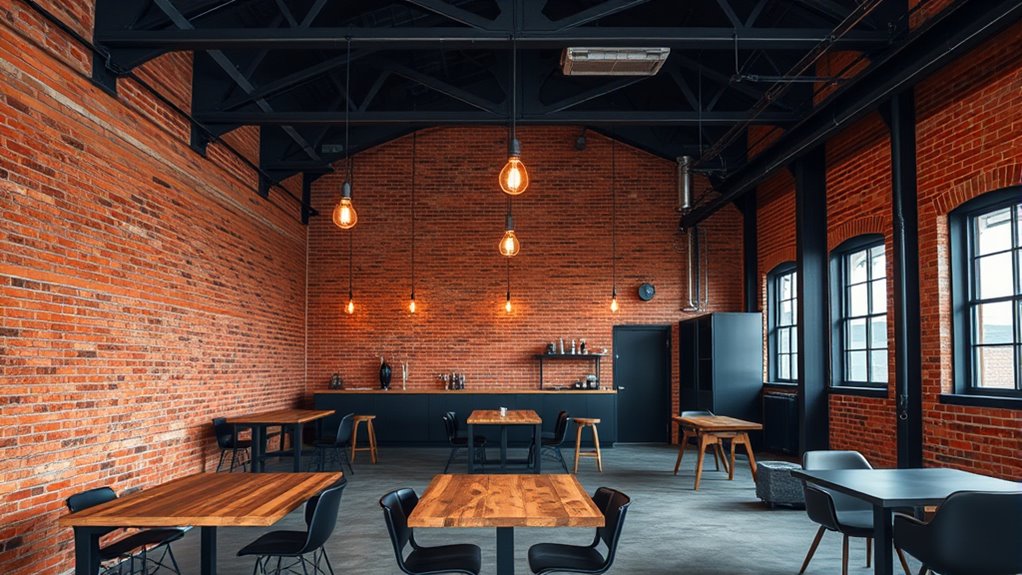
Blending vintage charm with modern design elements creates a mesmerizing balance that defines industrial style. This contrast heightens authenticity and visual interest, making your space stand out. To achieve this harmony, consider these key points:
- Combine reclaimed vintage materials, like brick walls or wood accents, with sleek, modern furniture.
- Use antique lighting fixtures alongside minimalist decor to foster a timeless yet current look.
- Mix weathered textures with polished metals and glass to create a dynamic interplay of old and new.
- Balance nostalgic elements with contemporary pieces to maintain a cohesive design that feels both authentic and fresh.
- Paying attention to paint application techniques can help enhance the textured and layered look characteristic of industrial interiors. Incorporating material choices that reflect both vintage and modern influences can further elevate this aesthetic. Additionally, understanding design principles such as balance and contrast can help create a more harmonious space. For example, integrating industrial automation concepts can streamline space management while preserving the style’s raw appeal. Being mindful of lighting design is also essential to highlight the textures and materials effectively. This perfect blend appeals to those who crave spaces that are both nostalgic and cutting-edge, making industrial style irresistibly versatile.
Emphasis on Durability and Sustainability
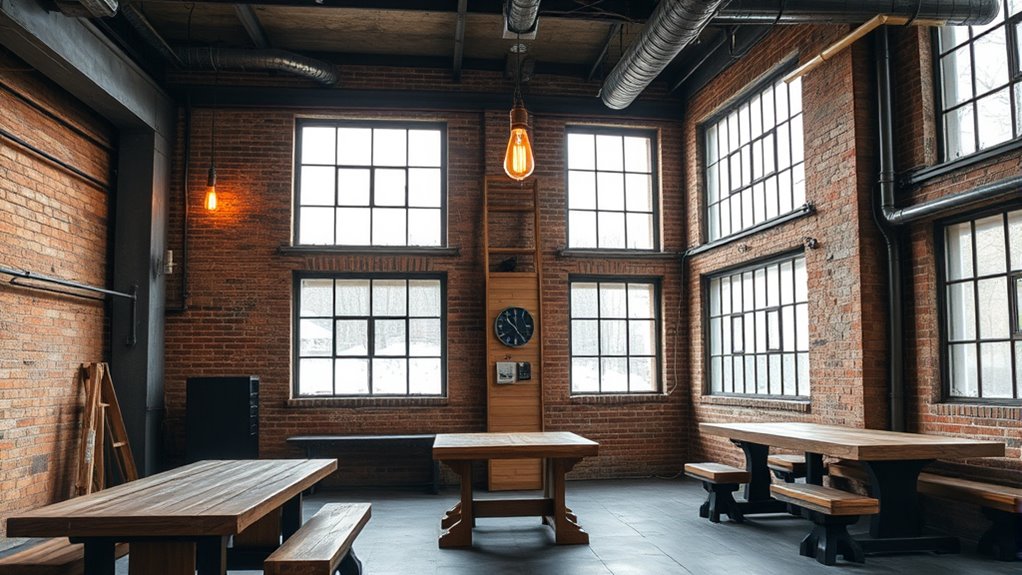
Industrial style prioritizes durability and sustainability by utilizing materials built to last, such as steel, concrete, and reclaimed wood. These materials guarantee your space remains long-lasting, reducing the need for frequent replacements. Reclaimed materials, like salvaged wood and recycled metal, make your decor eco-friendly by repurposing resources and minimizing waste. The rugged nature of industrial materials naturally promotes resilience, so your space can withstand daily wear and tear. Plus, many industrial elements are designed with sustainability in mind, incorporating eco-friendly practices like upcycling factory components into furniture. By emphasizing durability and sustainability, this style aligns with responsible living, offering a resilient, environmentally conscious aesthetic that stands the test of time while reducing your ecological footprint.
Spaciousness and Open-Concept Designs
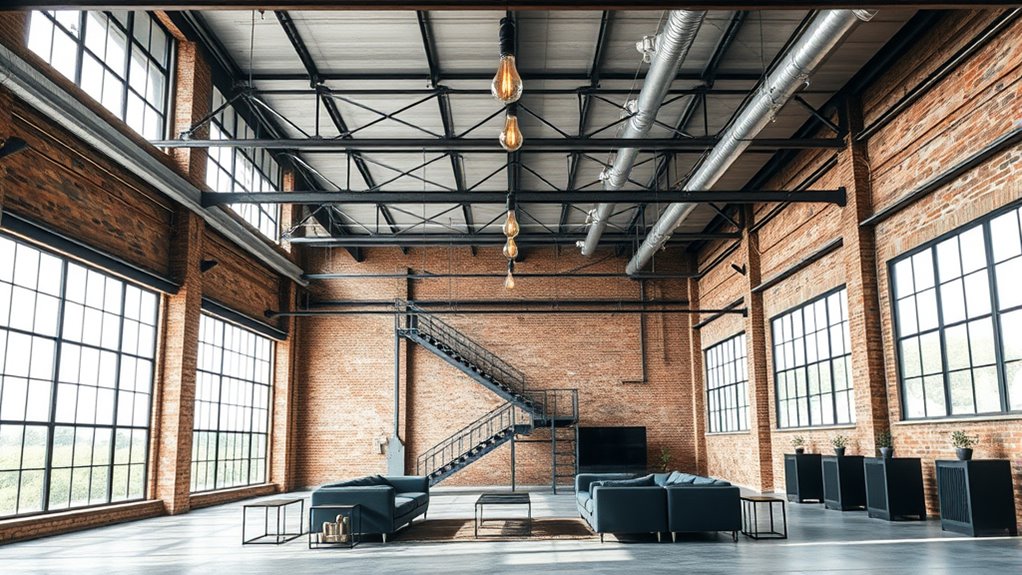
Industrial style thrives on large, open spaces that foster a sense of freedom and simplicity. With minimal walls and ample natural light, the design encourages an effortless flow between areas. This creates a spacious, airy environment perfect for socializing and relaxation. Additionally, spatial planning plays a crucial role in achieving the seamless, functional layout characteristic of industrial interiors, often incorporating industrial-inspired furniture to complement the aesthetic.
Emphasis on Large Spaces
Open floor plans are a hallmark of industrial style interiors, creating a spacious and airy atmosphere that feels both functional and inviting. This emphasis on large spaces enhances the open-concept design, making your interiors feel expansive. To achieve this, consider these key elements:
- Incorporate high ceilings to add vertical space and grandeur.
- Use large windows to flood the space with natural light.
- Expose structural elements like beams, ductwork, and brick walls for raw authenticity.
- Opt for multifunctional furniture that reduces clutter and maintains open flow.
- Incorporate locally sourced materials to add character and support sustainable practices.
Minimal Walls, Open Flow
Maximizing spaciousness is a defining feature of industrial style interiors, achieved through minimal wall partitioning that encourages an open flow between different areas. This design approach creates spacious layouts where living, dining, and kitchen zones blend seamlessly without barriers. The open flow enhances natural light penetration, making the space feel brighter and more inviting. Structural elements like exposed brick and beams take center stage, serving as focal points that add character and authenticity. Minimal walls not only improve circulation but also allow flexibility in furniture arrangements and zone function. This open-concept design fosters a modern, dynamic atmosphere, emphasizing spaciousness and functional simplicity. By reducing barriers, you create an environment that feels both expansive and effortlessly stylish, embodying the raw, unpretentious charm of industrial design.
Natural Light Abundance
Large, expansive windows are a hallmark of industrial interiors, flooding the space with natural light that enhances its airy feel. This abundance of natural light is key to creating a sense of spaciousness and openness. Here’s how:
- Large windows maximize daylight, reducing reliance on artificial lighting.
- An open-concept layout allows light to flow freely, eliminating dark corners.
- High ceilings accommodate taller windows, boosting spaciousness.
- Exposed structures like brick and metal reflect natural light, highlighting textures and weathered charm.
Together, these elements emphasize the raw beauty of industrial design, making your space feel bright, inviting, and expansive. The strategic use of natural light not only complements exposed structures but also transforms your home into a true showcase of industrial style.
Unique Character Through Weathered Surfaces
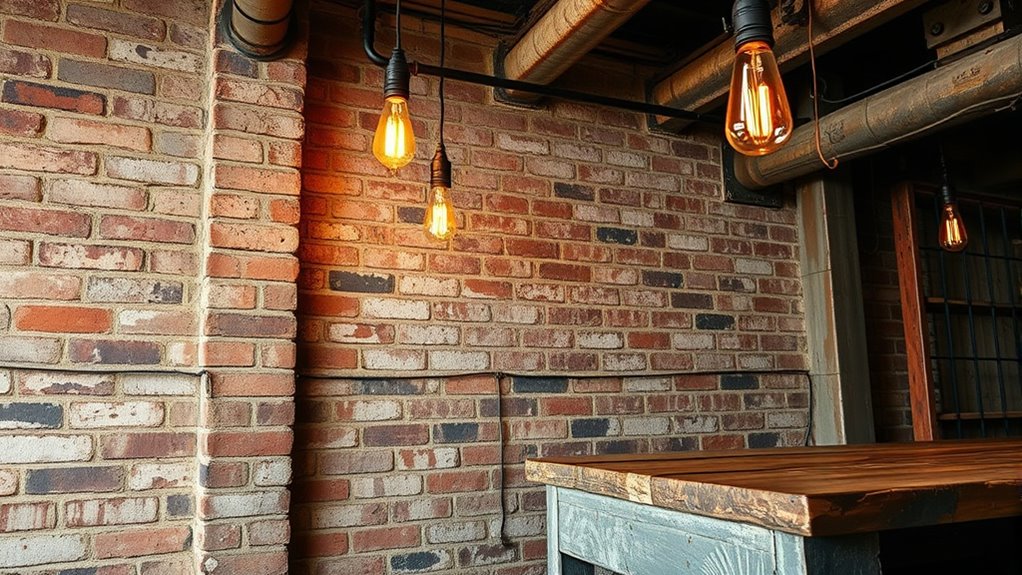
Weathered surfaces like rusted metal, distressed wood, and aged brick are essential elements that give industrial interiors their authentic charm. They showcase a natural patina and imperfections that add rich texture, making each piece and space feel truly unique. These surfaces tell a story of time and use, bringing a sense of history and character to your environment. The weathered look emphasizes authenticity, avoiding artificial finishes and highlighting durability. Each mark, crack, and worn spot contributes to the raw, honest aesthetic that defines industrial style. This rugged, imperfect beauty not only enhances visual interest but also celebrates the beauty of aging materials. Incorporating weathered surfaces also aligns with celebrity lifestyle insights, which often highlight the appreciation for authenticity and personality in design. Embracing authenticity in your decor can create a space filled with personality, depth, and a genuine connection to the past. Additionally, understanding the weathered surfaces as a deliberate design choice can inspire creative repurposing of old materials, adding further uniqueness to your space. Implementing proper maintenance and care can ensure these aged elements maintain their appeal over time by preventing further deterioration and preserving their character.
Versatility in Residential and Commercial Spaces
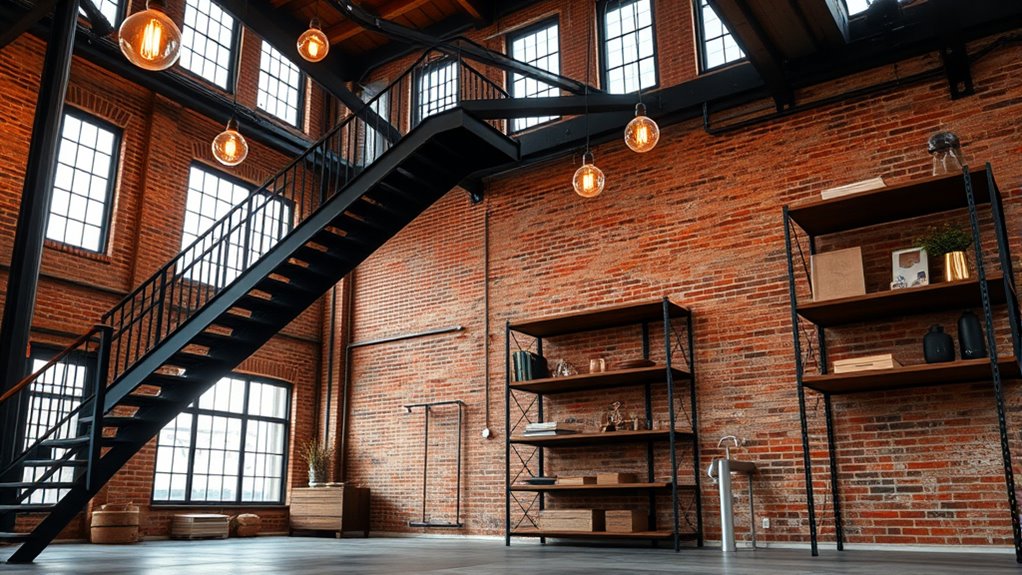
Industrial style effortlessly adapts to both residential and commercial spaces, offering a rugged yet refined aesthetic that works across various functions. Its industrial interior design creates versatile environments, whether for a cozy home or a bustling business. Consider these key features:
- Durable materials like steel, brick, and concrete ensure longevity in high-traffic areas.
- Open-concept layouts provide flexibility for customization in both homes and commercial settings.
- Raw textures and neutral palettes serve as timeless backdrops for diverse interior themes.
- Personalization options, such as vintage or reclaimed elements, make industrial spaces uniquely yours or branded.
- Incorporating water features like fountains or pools can enhance the ambiance and add a modern touch to industrial designs.
This adaptability makes industrial style a smart choice for creating spaces that are both functional and stylish, no matter the setting.
The Timeless Appeal of Industrial Materials
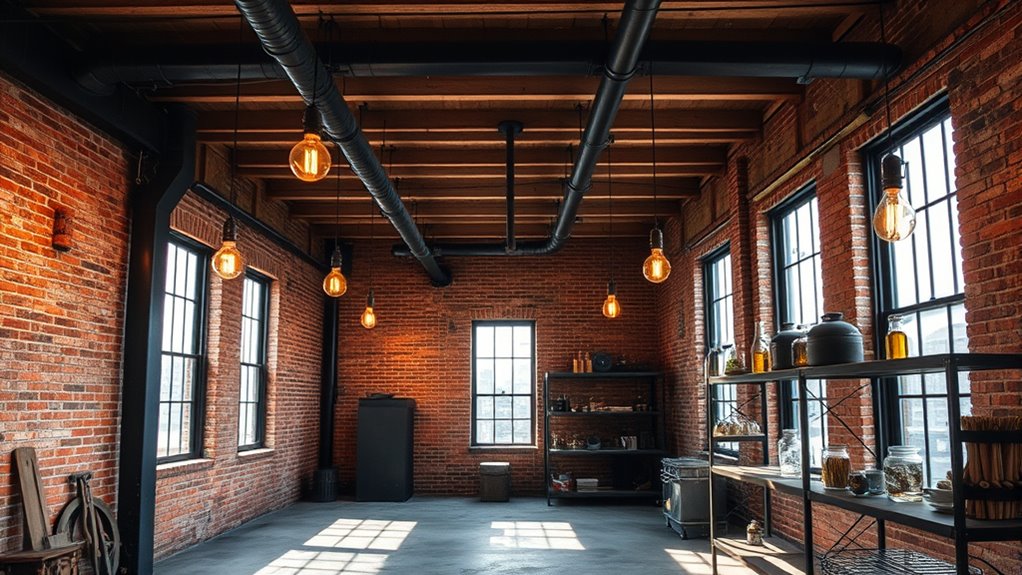
The enduring charm of industrial materials lies in their durability and authentic character, making them a cornerstone of timeless interior design. Metal, brick, reclaimed wood, and concrete naturally develop a rich patina over time, adding depth and history to your space. Weathered metal and distressed brick create a sense of authenticity and rawness that’s impossible to replicate with new materials. These elements are inherently timeless, maintaining their rugged appeal across changing trends. The natural imperfections and aged finishes showcase craftsmanship and a connection to the past, resonating with modern sensibilities. Plus, reclaimed materials support sustainable design, emphasizing longevity and eco-friendliness. Additionally, sustainable fashion principles highlight the importance of using recycled and ethically sourced materials in design. By embracing these authentic, weathered textures, you create an environment that’s both stylish and enduring, embodying the principles of timeless design.
Frequently Asked Questions
What Is the Concept of Industrial Style?
Industrial style revolves around embracing raw, unfinished materials like exposed brick, concrete, and metal fixtures. You see the beauty in structural honesty and functional design, often repurposing old factory spaces into stylish living areas. This style combines rugged, utilitarian elements with modern touches, creating a balanced, authentic look. It’s all about celebrating durability, simplicity, and the vintage charm of industrial spaces, making your home both timeless and uniquely appealing.
What Are the Characteristics of Industrial Design?
You notice industrial design’s raw materials, exposed structures, and open spaces. It features unfinished concrete, reclaimed wood, and metal surfaces that emphasize authenticity. The color palette stays neutral and muted, with grays, blacks, and earthy tones. Large windows and high ceilings create spaciousness and flood the room with natural light. Blending vintage, modern, and utilitarian elements, it tells a story of craftsmanship, durability, and rugged elegance that draws you in.
Why Choose Industrial Interior Design?
You choose industrial interior design because it offers a bold, authentic look that’s both stylish and functional. Its raw materials and open spaces create a modern, spacious feel, while its focus on sustainability aligns with eco-friendly values. You can personalize your space with vintage or eclectic decor, giving it character. Plus, its timeless mix of ruggedness and sophistication makes your home unique, versatile, and always in style.
What Styles Mix Well With Industrial?
You might think industrial style is a bold statement on its own, but it actually dances gracefully with many other styles. Mixing it with rustic or vintage elements highlights its raw charm, while pairing with modern minimalism emphasizes sleek simplicity. Scandinavian design softens its rugged edges with light woods, and bohemian adds vibrant layers. Contemporary touches bring in sophisticated metals and glass, creating an effortlessly balanced space that’s both functional and visually enthralling.
Conclusion
So, why is industrial style so irresistible? It’s like a magnet that draws you in with its raw authenticity and timeless charm. It blends vintage character with modern flair, creating spaces that feel both rugged and refined. Embrace the versatility and durability that make it perfect for any setting. Ultimately, industrial design isn’t just a style; it’s a statement—proof that beauty lies in imperfection and history’s whispers.


